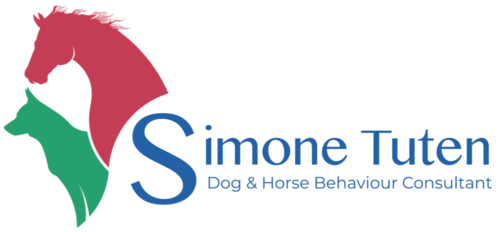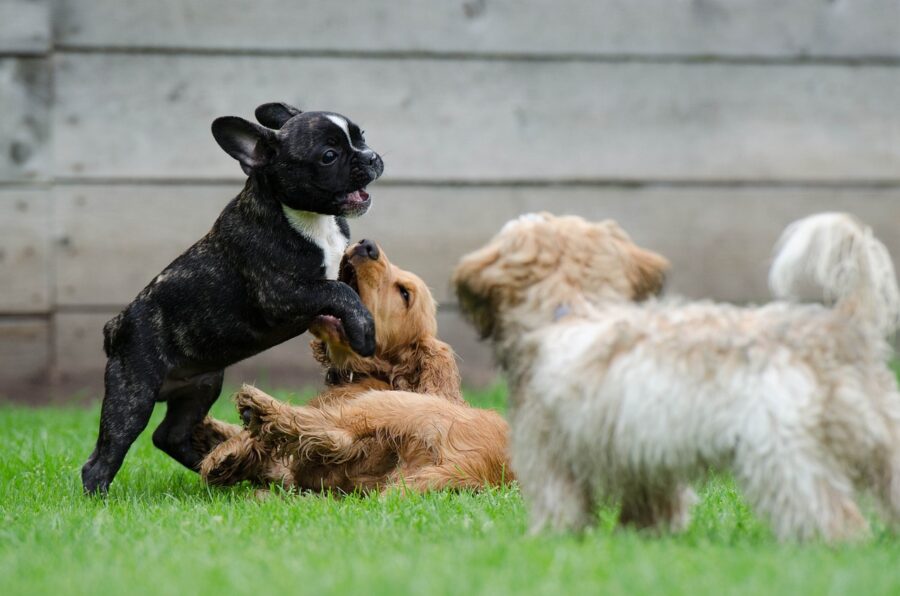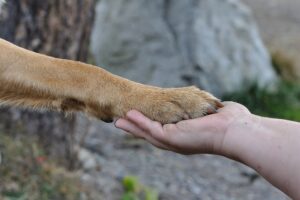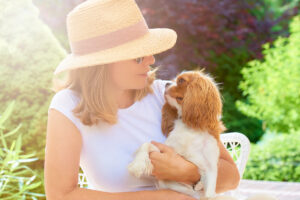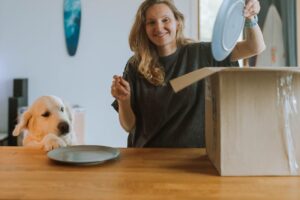Puppy play in puppy classes use to be very common, yet there are an increasing number of classes where puppy playtime doesn’t happen. It may surprise you that allowing puppies to play together off lead is a contentious issues amongst trainers. Some trainers don’t support puppies interacting even briefly on lead. Read on to learn more about puppy play in puppy classes.
Why is puppy playtime contentious?
Some trainers believe allowing interaction encourages puppies to focus on their human family less and results in dogs that see another dog and immediately want to go over to say hello and have a play. Where play is not set up or managed well this concern is valid. There are steps we can take to prevent this from happening.
Other trainers believe allowing interaction is important for several reasons, including the development of social skills and benefits of puppy playtime for a dog’s mental and physical health.
Where do I stand on this issue?
I prefer to give puppies the opportunity to interact with each other, ideally off lead play although that’s not always possible.
The opportunity to play with other puppies is something I have offered to over 3000 puppies in my classes since 2007.
Why do I include the opportunity to play?
Dogs are a social species
As a social and co-operative species, it’s really important for puppies to have the opportunity to learn to communicate and practice social skills, safely and in an appropriate manner.
Positive play experiences allow puppies to learn many things, including that unknown puppies can be fun (and not scary), they learn how to regulate themselves during play, how to calm down after a period of excitement, and ideally they can practice different play styles in a safe supervised environment with puppies of a similar age.
Puppies need to learn how to ‘speak’ dog and practice communicating in social settings with unknown dogs (that may look very different to their parents and litter mates).
Ideally this is done off lead, however, that is not always appropriate for each puppy or group of puppies. Setting puppies up for successful learning via play (or other interactions) with other puppies requires the puppy class trainer has a lot of knowledge and practical experience.
Providing puppies with the opportunity to play under an expert’s eye allows puppies to become more proficient at reading and responding to another puppy’s communication. A free for all play session can be harmful for puppies emotionally, mentally and physically, and contribute to dog directed reactivity or aggression as the puppy matures.
Play is also important for a dog’s well-being (that also includes play with their human friends).
We would like our puppy to have dog friends to play with
Most of us with pet dogs would like our canine friend to interact with other dogs at some stage. Whether that’s with our friends or family’s dogs, at day care, dog parks, dog beaches etc. Or introducing another dog into the family.
Knowing the preferences of our puppy helps us keep our canine friend safe and helps us set up dogs for pleasant interactions.
To do this successfully we need to understand canine body language as well as our canine friend’s preferences.
Puppies (and older dogs) have different preferences when it comes to close interaction or play with another dog. There are differences in:
- preferred play style,
- number of dogs playing, interacting or in close proximity (most dogs prefer to play with one other dog at a time), some don’t want to play with a friend if there are other dogs in close proximity
- if they wish to interact on lead or off lead (some puppies behave quite differently on vs off lead),
- how long our canine friend wants to interact for (or is able to interact for before becoming over aroused or displaying less than ideal body language)
- ability to recognise if the other dog wishes to play at that time (this is where understanding canine body language is essential)
This is information that puppy carers can learn during puppy interaction time. It also provides information to guide future interactions (or not).
Behaviour change is easier and more effective in puppyhood
From my perspective as a Certified Dog Behaviour Consultant (certified by the IAABC) I use puppy playtime to effectively help puppies reduce fears or undesired social behaviours.
I want to be able to identify potential problem behaviour at as young an age as possible. Not all potential problem behaviours are apparent while puppies are on lead.
Early identification of social skills deficits or inappropriate behaviours during play and interaction with other puppies means earlier intervention. Early intervention is best when it comes to addressing potential or problem behaviours. Changing behaviour in young puppies is quicker and more likely to be successful than working to change undesired behaviours when the puppy is older.
- I can use off lead puppy play time to help
- a puppy that is worried/shy/fearful/anxious of people. I can help build that puppy’s confidence with people while that puppy is playing with other puppies
- puppies that are shy/worried/fearful of other puppies build confidence and their social skills
- puppies overcome fear of novel objects by following the lead of a puppy play partner
- puppies learn how to approach another puppy appropriately, rather that rushing in and immediately pouncing on another puppy
- teach puppies to regulate their play and calm down after excitement (a very valuable skill)
It’s fun watching puppies have fun
Let’s face it, it is great fun watching puppies play and have fun. Good off lead play interactions are enriching for ourselves and the puppies in our care.
Puppy play skills and knowledge I like to share with my clients
- About their puppy’s preferred play style
- About their pups play preferences e.g. duration, number of dogs at once
- Body language
- How and when to interrupt puppy play
- How to set up for off lead interactions
- If off lead interactions are appropriate for their dog
- How to avoid common pitfalls including dogs focusing on other dogs, or running off as soon as leads are removed
- In some classes we can even start teaching a puppy to come when called (recall) away from a play mate and do off lead training
It’s important that puppy carers apply the knowledge and skills gained in puppy classes to situations outside the puppy classroom.
What does well managed puppy play look like?
- Play is not a free for all
- Care is taken to select play partners that are compatible
- Shy puppies are not forced into play and are allowed to keep their distance
- Boisterous puppies are managed so they don’t overwhelm quieter players
- Play is interrupted regularly; especially where puppies are not including pauses in their play bouts.
- Play sessions are quite short
- Play is monitored for signs of over arousal and that all puppies continue to have a positive experience.
Interesting fact
It took me about two years or participating in 4 – 8 puppy classes per week to become confident in managing and running off lead play. This includes gaining experience and learning about how to modify puppy behaviour during play time.
After mentoring many trainers in puppy interactions 2 years seems to be the average. There’s a lot for us trainers to learn and we need the practical experience to be able to offer great quality puppy classes that includes well managed puppy playtime.
Want to know more?
To find out more about my puppy classes follow my Facebook page or visit my puppy class page
For trainers that would like to learn more about offering puppy playtime feel free to send me a message.
